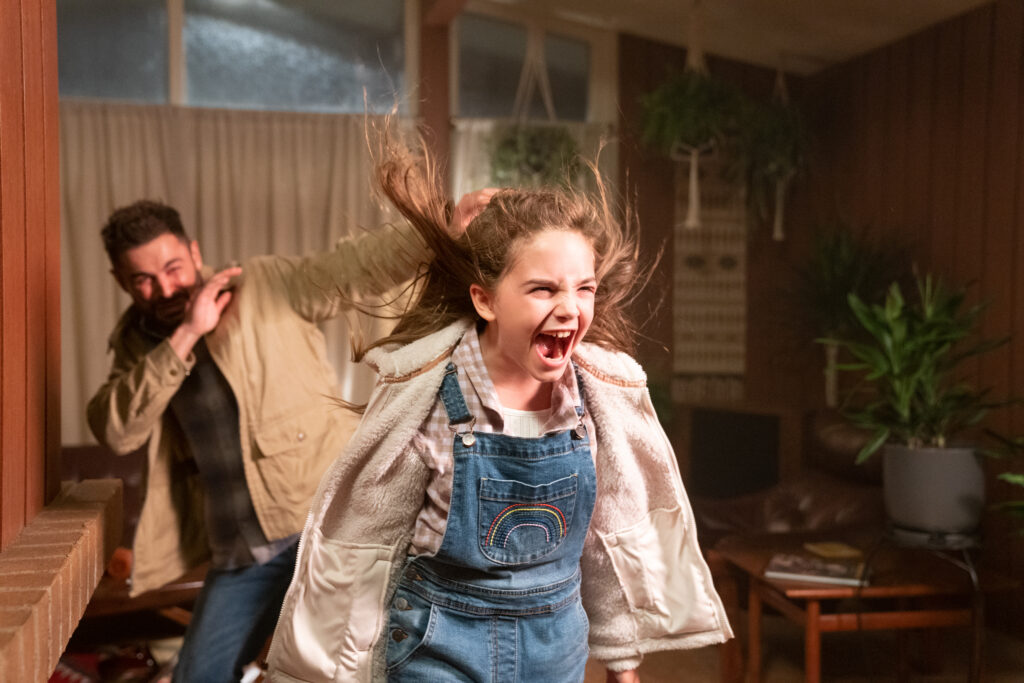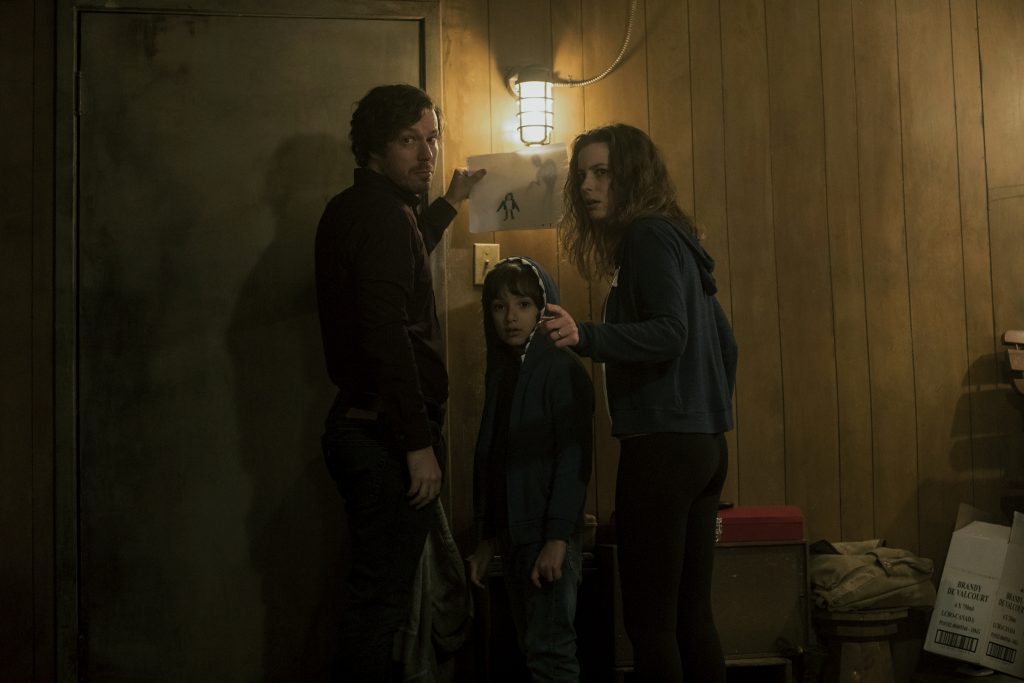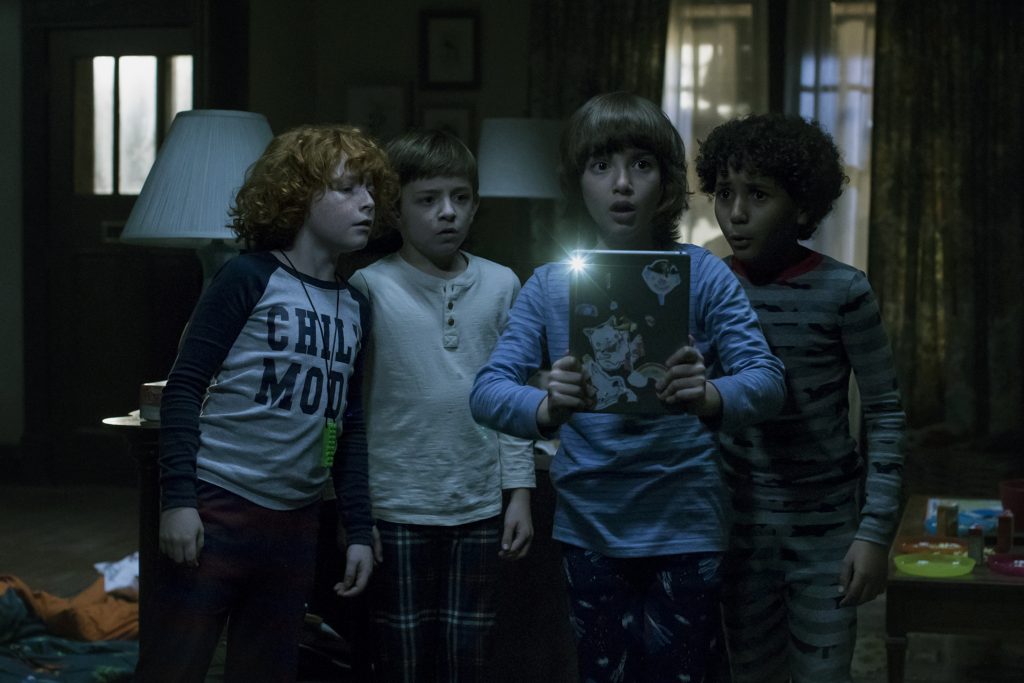May 12, 2022
by Carla Hay

Directed by Keith Thomas
Culture Representation: Taking place mostly in Lewiston, New York, the horror film “Firestarter” features a cast of predominantly white characters (with some African Americans, Latinos and one Native American) representing the working-class and middle-class.
Culture Clash: A psychic father goes on the run with his 11-year-daughter, who has the deadly ability to start fires through her mind power, and they are fugitives of the U.S. government and law enforcement.
Culture Audience: “Firestarter” will appeal primarily to people who are fans of star Zac Efron and the Stephen King novel on which the movie is based, but the movie is another failed attempt to do justice to the book.

The 1984 and 2022 versions of “Firestarter” are both awful horror movies for different reasons. The 2022 version has better acting than the 1984 version, but the screenplay is worse. It’s a dull, incoherent mess with the last 15 minutes as the most heinous. The 2022 edition of “Firestarter” is from the horror-oriented Blumhouse Productions, which has a “hit and miss” track record, when it comes to putting out quality films. The same can be said of any movie adapted from a Stephen King novel or short story. “Firestarter” is based on King’s 1980 novel of the same name.
Directed by Keith Thomas and written by Scott Teems, the 2022 version of “Firestarter” should get a little credit for not being a copycat of the 1984 version. But that’s not saying much when the 2022 version is a tedious remake that takes too long to get to the “fugitives on the run” aspect of the story that was shown right away in the 1984 version of “Firestarter.” The first two-thirds of the 2002 movie are bogged down with a lot of repetitive scenes that don’t effectively further the story and in fact stall it on very monotonous levels. And the ending of the 2022 “Firestarter” movie is drastically different than the ending of both the book and the 1984 movie.
And even worse: The title character in the 2022 version of “Firestarter” goes from being a compassionate child to being a ruthless killer during a certain part of the movie. It’s a huge change in personality that looks very phony and hard to believe. People watching “Firestarter” already know that this girl has the ability to kill people with her fire-starting powers. But when she starts killing for reasons that aren’t really justified (and one of her murders is particularly shocking and despicable), it’s going to be a problem for a lot of audience members to see an 11-year-old child depicted in a way that doesn’t stay true to the book or the 1984 movie.
In both movies, a father named Andy McGee and his pre-teen daughter Charlene “Charlie” McGee are being hunted by the U.S. government because they both have unusual abilities as the result of a top-secret experiments that the father underwent when he was a college student. The research was being conducted in a lab by a mysterious government agency called The Shop, which administered a psychedelic drug called Lot 6 to the research participants, who were usually young people desperate for money. Andy met his future wife Vicky (the mother of Charlie) during these experiments.
As a result of these experiments, Andy developed psychic abilities where he could exert control over other people’s minds. Vicky also developed psychic abilities too, but not to the extent that she had mind control powers. Meanwhile, Charlie’s psychic powers came with the ability to start fires with her mind. She’s most likely to start fires when she’s angry or afraid.
Both movies also have a scene where Charlie gets angry at her mother and accidentally sets her mother’s hands on fire. And both movies show that when Charlie starts to get worked up, the temperature rises considerably wherever she’s at, and people start to sweat as a result. Charlie has to be trained to control her fire-starting abilities, but any training she gets isn’t enough. Meanwhile, Andy’s psychic abilities put a strain on his mind, which has internal hemorrhaging every time he uses his abilities, resulting in blood coming out of his eyes.
Back when Syfy was called the Sci-Fi Channel, it had a 2002 miniseries called “Firestarter 2: Rekindled,” which was about Charlie as an adult. This low-quality sequel series is not essential viewing along with any “Firestarter” movie. In fact, it’s not essential viewing for anyone who likes good entertainment.
In the 1984 “Firestarter” movie, Vicky is already dead, but she is seen in flashbacks. In the 1984 version of “Firestarter” (directed by Mark L. Lester and written by Stanley Mann), the McGee family was played by Drew Barrymore as Charlie, David Keith as Andy, and Heather Locklear as Vicky. It’s a very sloppily edited film with terrible dialogue and campy theatrics, including over-acting by Keith and co-stars such as Martin Sheen and George C. Scott.
In the 2022 “Firestarter” movie, a lot of screen time (about half of the movie) is taken up showing Andy (played by Zac Efron) and Vicky (played by Sydney Lemmon) raising 11-year-old Charlie (Ryan Kiera Armstrong) in Lewiston, New York. (The movie was actually filmed in the Canadian city of Hamilton, Ontario.) Both parents have very different opinions on how to handle Charlie’s fire-starting abilities. Vicky strongly believes that they should train Charlie to control these abilities. Andy disagrees.
“We have to protect her,” Andy tells Vicky, who replies: “Training is protecting.” There’s cause for concern, because Charlie has told them that, after a three-year hiatus, her “bad thing” has started to come back. “Something feels weird. My body.” And she says it’s not puberty.
The experiments that Andy and Vicky underwent in collage are breezed through in an opening-credits montage that shows quick flashbacks and voiceovers. These experiments were led by Dr. Joseph Wanless (played by Kurtwood Smith), who is seen later in the movie in a scene that doesn’t have very good placement in the story. The U.S. government has been looking for people who underwent these experiments to possibly use their superpowers as weapons of mass destruction.
The first half of the 2022 version of “Firestarter” has a lot of monotonous scenes of Andy, Vicky and Charlie at home, work or school. Andy’s backstory is briefly explained in the experiments montage, where he tells Dr. Wanless in an interview that he was orphaned at the age of 7 years old because his parents died in a car accident. When Andy is asked if he’s ever had an authentic psychic experience, he reveals that he had a premonition about this fatal car accident a week before it happened. The movie doesn’t bother to reveal anything about Vicky’s family background.
Andy works as a life coach/therapist, where he puts people through hypnosis/mind control to solve whatever personal problem they want to be solved There’s an unnecessary scene that shows Andy doing just that in a session with a client named Darla Gurney (played by Hannan Younis), who wants to quit smoking. Apparently, Andy and Vicky never thought about Andy controlling Charlie’s mind to brainwash her into not starting fires. Maybe Charlie is immune to this kind of mind control, but the movie never says so either way.
The 2022 version of “Firestarter” also spends considerable time showing Charlie in school, which is something that the 1984 “Firestarter” movie didn’t waste time showing. Charlie (who is a quiet and introverted student) is harassed in school by a bully named Gavin (played by Gavin Maciver-Wright), who picks on Charlie because he thinks she and her family are weird. For example, Gavin taunts Charlie because her parents won’t let her use the Internet.
Charlie’s teacher Ms. Gardner (played by Tina Jung) gently suggests to Charlie that Charlie can use the Internet at school to help her with her homework, but Charlie says that her mother has told her that using computers for extended periods of time can cause health problems. Later at home, Charlie pleads with her mother to get Internet access in their home.
Vicky is firm with her response: “That stuff rots your brains. We can’t afford it right now.” Charlie later finds out the real reason why her parents don’t want to have Internet access or computers: They think it will make the U.S. government easier to track them and spy on them.
In a scene that takes place in a school gym, the kids are playing dodgeball, and Gavin cruelly throws the ball at the back of Charlie’s head. The throw is hard enough to definitely hurt Charlie, who runs away and hides in a school restroom. Gavin calls Charlie a “loser” and sneers, “Yeah, run away, you freak!”
Ms. Gardner is the teacher on duty, so she follows Charlie in the restroom and is shocked to see the restroom filled with smoke. And as soon as she walks in, Ms. Gardner sees a closed restroom stall have its door blown wide open, as if an explosion was set off in the stall. The teacher sees Charlie come out of the stall, so Charlie gets in trouble for the damage.
The police are called to investigate. Charlie’s parents try to smooth things over and insist that Charlie did not set off an explosive device, but they can’t say the real reason why the restroom stall exploded. When the parents are at home, Andy has this to say about this explosive incident: “Our cover’s been blown.” Andy knows it’s only a matter of time before The Shop finds out about Charlie.
And he’s right. The McGee family gets on the radar of an official from The Shop named Captain June Hollister (played by Gloria Reuben), who sets a plan in motion to capture Andy and Charlie. She contacts an embittered war veteran named Rainbird (played by Michael Greyeyes) to enlist him as a hired mercenary. His mission is to find Andy and Charlie and bring them in for research. Captain Hollister insists that unlike previous mercenary jobs that Rainbird has done for the U.S. government, this quarry (Charlie and Andy) must be brought back alive.
The movie hints that Rainbird has been mistreated by the government, so Captain Hollister tries to appeal to him, by saying that his mistreatment came from “the old guard … I’m the new [guard].” Rainbird also drops a big hint about his own personal experiences with government experiments: “Before they tested their poison on pretty young co-eds, they had to use the lab rats.”
The Rainbird character was also in the “Firestarter” book, but he was not the main pursuer in the 1984 “Firestarter” movie. Instead, 1984’s “Firestarter” had a bunch of nameless government agents (all men, usually in business suits) in physical pursuit of Andy and Charlie, while Rainbird (played by Scott) makes his move much later in the story. In the 2022 “Firestarter” movie, it looks completely unrealistic that Rainbird is the lone person (without any real backup) looking for Andy and Charlie. If Andy and Charlie are so important to The Shop, there should be teams of trained professionals who go out looking for these two people with dangerous psychic abilities.
At any rate, Rainbird breaks into the McGee home, which results in Andy and Charlie escaping and going on the run without Vicky, whose fate is shown in this home invasion scene. Both “Firestarter” movies have a scene of Andy and Charlie temporarily hiding at a rural farm home. In the 2022 version of “Firestarter,” this hideout scenario happens when fugitives Andy and Charlie get a truck ride from a stranger named Irv Manders (played by John Beasley), who ends up inviting Andy and Charlie into his farm home for a temporary place to stay.
Not all of Charlie’s victims are human. After Charlie and Andy go on the run, there’s a scene where Charlie sees a stray cat and tries to pet it, but the cat scratches her out of fear. This unlucky feline then gets scorched to death.
When Charlie and Andy bury the cat and pray over this makeshift grave, Andy seems more concerned about the cat than the fact that Vicky is no longer with them. Vicky seems almost like an afterthought in this prayer scene, when Charlie says offhandedly toward the end of the prayer: “And bless mommy too,” as a reminder to Andy that they shouldn’t just be praying about the dead cat.
One of the most unrealistic aspects of the 2022 version of “Firestarter” is that when people get burned by Charlie’s fire, they almost never scream out in pain. It’s an odd choice to not have this type of screaming in a horror movie. There are also unrealistic scenes where Charlie should be burned by all the flames or overcome by all the smoke in a blazing room, but she’s not.
Most of Charlie’s freakout fire blazes don’t happen until the last third of the movie, but hardly anything in this boring sludge of a story is scary. The acting in the 1984 “Firestarter” movie was very over-the-top, and it was bad in a “train wreck” type of way. In comparison, the acting in the 2022 “Firestarter” movie is a little more professional and polished, but much of it is too restrained and often downright lackluster, especially from Efron, who is never convincing as a grieving husband.
Charlie goes from being a meek child who’s scared of her fire-starting powers for most of the movie to a sudden transformation into a rampaging, cold-blooded serial killer. It’s a jarring and extreme change that makes Charlie look like she’s got a personality disorder too. The ending of the 2022 version of “Firestarter” is what really makes it irredeemable, because it’s just mindless mayhem that tries to overcompensate for the lack of scares in most of this disjointed, bland and misguided movie.
Universal Pictures will release “Firestarter” in U.S. cinemas and on Peacock on May 13, 2022.


